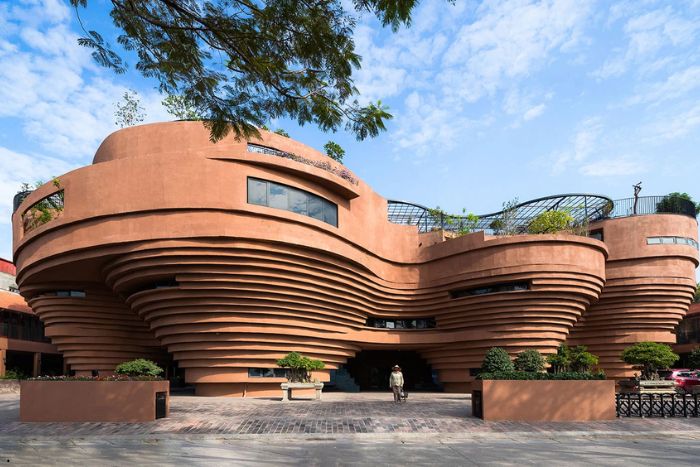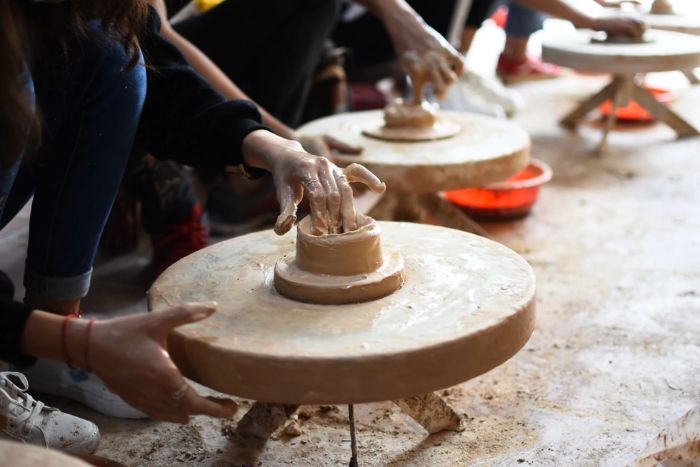2 Days In Hanoi: Visit Traditional Craft Villages With Susan Family

During our stay in Hanoi, my family and I spent 2 days exploring the traditional craft villages on the city outskirts. These villages are worth a visit if you enjoy discovering cultural values through traditional crafts and admiring the beautiful products made by local artists. We hope the experiences shared in this Hanoi travel itinerary for 2 days will be helpful for your trip to these charming handicraft villages!
Table of Contents
I. Overview of our 2-day Hanoi itinerary
In Hanoi, the capital of Vietnam, in addition to famous tourist sites like the Old Quarter, night markets, pagodas, and museums, the traditional craft villages embody timeless traditional beauty, a true symbol of this capital. Our 2 days in Hanoi included visiting two iconic traditional villages: the Bat Trang Pottery Village and the Van Phuc Silk Village.
At these handicraft villages in Hanoi, we explored places filled with spirituality, such as temples dedicated to the founders of the trades, centuries-old houses, and workshops where artisans create exquisite products using methods passed down through generations.
The highlight of our 2-day trip to Hanoi was creating handmade items in the village. For me, it was an unforgettable experience, combining the discovery of local culture with an immersion in traditional craftsmanship.

II. Detailed Hanoi travel itinerary for 2 days
1. Day 1: Hanoi - Bat Trang Pottery Village
We booked a full tour with the Vietnam travel agency Autour Asia. In the morning, the driver picked us up at the hotel and drove us to Bat Trang Pottery Village, located about an hour outside of Hanoi. The road was a bit bumpy, but the air was fresher than in the city.

Upon arriving at this Hanoi handicraft village, we were immediately impressed by the houses displaying ceramic products all along the street. Our first stop was the Bat Trang Pottery Museum, whose unique architecture resembles giant pottery pots. The museum features a collection of pottery works from local artisans, ranging from the oldest to the most recent.
Next, we had the opportunity to create our own piece of pottery, an activity that my children particularly enjoyed. Everything we needed was provided, and we were guided in crafting our work.

In the afternoon, we explored the pottery market, where prices vary depending on the quality of the work. The vendors practiced tourist pricing, which made negotiating a bit harder, but we managed to buy a nice tea set.
Our last stop in Bat Trang Village was the Mau Temple, a sacred site dedicated to an iconic female figure of patience and wisdom. Then, we returned to Hanoi to avoid traffic jams. End of the first day of the 2-day Hanoi itinerary.

2. Day 2: Hanoi - Van Phuc Silk Village
On the second day of our 2-day Hanoi itinerary, we visited the Van Phuc Silk Village, just 30 minutes from downtown. Upon entering, we passed through a traditional red brick gate, followed by colorful streets adorned with hanging umbrellas and murals depicting the daily life of the villagers.
Every house in the village is a silk factory, where brightly colored silk fabrics with various patterns are woven. I had the opportunity to watch artisans work with weaving looms.

Shopping in Van Phuc Silk Village is a must, although the prices are not as low as one might expect, with scarves ranging from 300,000 VND (about 12 USD) to 1,000,000 VND (about 40 USD). Negotiating here is more challenging than in Bat Trang Pottery Village.
Before leaving, we visited the Tram Gian Temple, a sacred site perched on a hill, housing numerous wooden statues. We then had lunch at a local restaurant before returning to Hanoi.

III. FAQ and travel tips for 2 days in Hanoi
1. What is the weather like in Hanoi for 2 days?
We traveled to Hanoi in November. The weather in Hanoi during our 2-day trip was pleasant, with warm days and cool evenings. If you're traveling at the end of the year, bring a coat for the evenings, but you can wear a T-shirt during the day.
I’ve heard that the weather in Hanoi in the summer, from May to June, is more intense. To visit the artisanal villages on the outskirts, it’s better to leave early and take a car to avoid heatstroke.
2. Travel tips for the handicraft villages in Hanoi?
- During your visit to the artisanal villages in Hanoi, you’ll be walking a lot, so wear comfortable clothing and appropriate attire if you're visiting temples, along with sneakers or comfortable footwear.
- Before buying, ask for the price and negotiate, but make sure you buy after agreeing on the price.
- After purchasing, ask the seller to pack your items carefully, especially pottery, to prevent breakage.
- You can also ask guides or local agencies for recommendations on souvenirs to buy.
- In Bat Trang Pottery Village, be cautious with fragile items, especially if you’re traveling with your kids.

I hope the information on the traditional craft villages in my Hanoi travel itinerary for 2 days will be helpful to you, especially if you’re looking for a unique cultural experience away from the city's popular tourist spots. Additionally, there are many other artisanal villages around Hanoi, so I look forward to coming back to this beautiful country and exploring more handicraft villages. I also want to thank Eliese for her valuable support in organizing my Hanoi travel itinerary and for suggesting wonderful places to visit. I highly recommend Autour Asia to all travelers planning to travel to Vietnam and other Southeast Asian countries!
In addition to Bat Trang and Van Phuc villages, Hanoi is home to several renowned handicraft villages, showcasing Vietnam's rich cultural heritage.
- Ha Thai village is famous for its stunning lacquer paintings, perfect as unique souvenirs.
- Chuong My village is the ideal place to find authentic Vietnamese "nón lá" (conical hats).
- Dao Thuc village attracts visitors with its water puppetry, a fascinating traditional art.
- Finally, Phu Vinh village is known for its intricately woven rattan products, highlighting local craftsmanship.
Each village offers a unique immersion into traditional techniques passed down through generations. These destinations are perfect for discovering local skills and bringing home authentic, high-quality souvenirs.
Yes, you can buy Vietnamese ao dai in Van Phuc Silk Village, renowned for its high-quality traditional silk production.
Many shops in the village offer ready-to-wear or tailored ao dai made from local silk. Don’t hesitate to ask artisans for advice to personalize your outfit.
Additionally, Hanoi also has many places in the city center selling ao dai, making it convenient for visitors. Please refer to Where to buy ao dai.
Related travel guide
Other similar articles
CUSTOMIZABLE BY LOCAL EXPERTS
Personalized trip at the original price!
REFUND GUARANTEE
We believe in our work and promise to give you money back.
GOOD PRICE / QUALITY
95% satisfied more than expected!
24/7 LOCAL SUPPORT
We are always available online to provide assistance at any time.
Most read articles
Autour Asia is highly recommended on
Embracing the mission of "Satisfied more than expected" and providing authentic experiences, we have received numerous recommendations on reputable travel forums:























